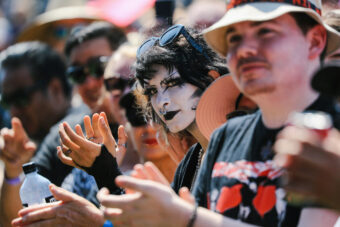The history of hip-hop is predicated upon someone doing something that somebody else told them they weren’t allowed to do. At the beginning, it was idyllic mythmaking stuff like turning a turntable into a musical instrument and scratching the damn records. Then, it’s N.W.A and other rappers deciding that violent lyrics no longer have to be a metonym for mad skills and can mean actually murdering people. When Nas cherry-picked the finest producers from his city and sculpted a classic, bending the one-rapper-one-producer rule, it was a bit of a cheat. So was Puff Daddy and friends sampling the most obvious hits with little panache. And, the 50 Cent of his 50 Cent Is The Future mixtape era, rapping over other peoples’ beats and talking unprecedented levels of shit, was too.
Those were all “Oh wait, you can do that?” moments. And rap quickly absorbed these shortcuts and never looked back. Yet, even with hip-hop’s roots in rule-breaking for better or worse, 50 Cent seemed like the start of something else. In addition to his savvy embrace of mixtape culture, 50’s bulletproof immortal shtick, the fact that he looked like a MacFarlane Toys-designed action figure (perpetrated in the video for “In Da Club”), all those rapped reminders that he was shot a whole bunch of times — every bit of it seemed fairly ridiculous. Much of 50 Cent’s appeal was summed up in an exchange that music writer Chuck Eddy had with his son. From “Pazz & Jop Ballot 2003,” in Eddy’s book Rock N’ Roll Always Forgets:
“I really don’t get 50 [Cent] at all: I mean, OPEN YOUR FUCKING MOUTH WHEN YOU RAP, OKAY DOOFUS? Jeez!! But when I tell that to Sherman, he just stares and says, “But Dad! He raps like that because he got shot in the face!!” Which is very important. As are his eight other bullet holes. Because to 12-year-old suburban white kids all over the country (who won’t care so much about Eminem anymore, mark my words), 50 showed up as a true-life, built-in Superhero.”
50 Cent, heel amongst heels, seemed cynical on an almost unprecedented level. The first guy to truly morph rap into professional wrestling levels of douchebaggery. Ultimately, that cynicism got the better of him, in a markedly quick span of time. Get Rich or Die Tryin’, an okay grunt-rap album that needs about 30 minutes lopped off of it, sold six million copies. Then, on the 2005 follow-up The Massacre, his hits were stuff like “Candy Shop” and “Just A Lil’ Bit.” On 2008’s Curtis it was, “Amusement Park,” which was a lot like “Candy Shop” (both of which were a lot like Lil Kim’s 50 Cent-featured “Magic Stick”). Even a song with a title like “I’ll Still Kill” had to have some Akon on it, just to go down a little smoother. 2009’s Before I Self Destruct is stunningly forgettable.

Also Read
The Senator Is Pissed Off
Then, rap changed, and people stopped buying albums, and an eccentric like Lil Wayne and an auteur like Kanye West moved things away from 50 Cent and company’s wigger-friendly chest-puffing. 50 had a nice run, it seemed, though not long enough or significant enough to afford him the level of success and respect he has commanded. These days, he’s more like a wounded bully than a snarling villain. Recent releases seem designed to suggest his pre-Get Rich or Die Tryin’ mixtape style: Last December’s The Big 10 barked but never got around to biting; May’s The Lost Tape was dogged by ridiculous crossover attempts; and last week’s 5: Murder By Numbers, supposedly the follow-up to Before I Self Destruct, instead given away for free, is grumpy and perfunctory.
5: Murder By Numbers begins with 50 parodying Rick Ross’ “I’m Not A Star” (“I’m still the shit, I’m rich already”), harking back to a three-year-old beef 50 lost. Rather than seeming unflappable, or exemplifying his legendary last-word assholism, it sounds like a denial of reality as deluded as anything Bawse has released. “Money” turns the accumulation of wealth into a tedious, compulsive act. On “Roll That Shit,” getting high feels like a drag. “Turn The Lights On” views sex as a series of orders and demands. I barely even remember the rest of the tape. 5: Murder By Numbers is a good reminder that even classic mixtape Fiddy was a novelty act. A loudmouthed jerk at a time when rap needed one of those pretty bad. So, can we just stop caring about the guy, now? How about we just admit that he was never very good?
There are however, two songs that suggest a glimmer of self-awareness left in Mr. Cent: “United Nations” and “Can I Speak to Her.” On “United Nations,” 50 Cent actually raps about his life as it is right now, not the comic-book crime-world image he likes to conjure up: “I’m back off a paycation / Can you believe it? / I’m getting paid on vacation / Yeah, I’mma keep niggas forever hatin’ / They thought I was going down, now look I’m levitatin’ / I’m with Deepak meditatin’ / Funding the World Food Program / Finna solve world hunger, goddamn.” There’s a lot to unpack there. It’s a sly diss directed towards Jay-Z and Kanye West and their neo-Talented Tenth assertions. At the same time, it’s tasteless and gauche, with 50 suggesting he’s just a hustler who got a free trip to Africa out of the WFP. It’s funny stuff.
“Can I Speak to Her,” featuring ScHoolBoy Q is the highlight of the tape, if only because one of the rappers on it sounds hungry: “Money, power, and drugs, my only reason to love / Never played cops and robbers, nigga, we played Crips and Bloods.” Those lines aren’t any more enlightened or edifying than 50’s warmed-over sex, money, and guns grump-outs, but Q actually cares about how he strings those words together and how they’re exhorted. It’s the sound of the new lapping the old, and the old leaning on a pile of money and a thug-life crutch, not really giving a shit, but getting up and pretending like he does, anyway. You gotta do something, right?




